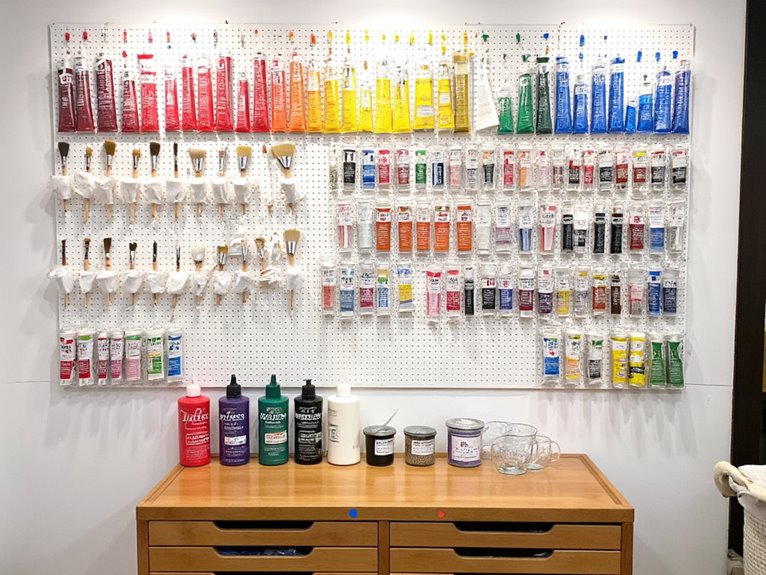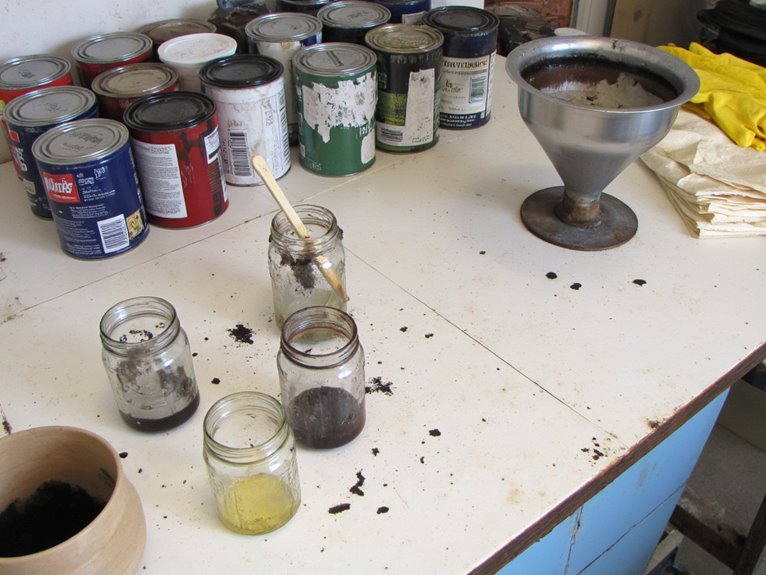We are supported by our audience. When you purchase through links on our site, we may earn an affiliate commission, at no extra cost for you. Learn more. Last update on 1st July 2025 / Images from Amazon Product Advertising API.
Store your paints in temperatures between 59°F and 81°F using airtight metal or plastic containers in cool, dry locations away from direct sunlight and heat sources. Clean container rims thoroughly before sealing and use plastic wrap for extra protection against air exposure. Organize paints by type and finish while implementing a first-in, first-out rotation system. Monitor for signs of separation, unusual odors, or consistency changes that indicate spoilage. The following detailed guide covers advanced preservation techniques and quality assessment methods.
Notable Insights
- Store paints in cool, dry, dark areas between 60°F-80°F away from heat sources and flames.
- Use airtight metal or plastic containers, cleaning rims thoroughly before sealing to prevent air exposure.
- Label containers clearly with paint type, name, and date for easy identification and rotation.
- Group paints by type and finish, using first-in-first-out organization to prevent expiration.
- Monitor paint condition regularly for signs of separation, contamination, or changes in consistency.
Choosing the Right Storage Location and Environment
While proper paint storage might seem straightforward, the location and environment you choose will directly impact your paint’s quality, safety, and lifespan. Your storage space must maintain temperatures between 60°F and 80°F to prevent component separation and premature drying.
Choose cool, dry, dark areas away from direct sunlight and heat sources.
Fire safety requires storing paints away from open flames, electrical equipment, and incompatible materials like oxidizers. Use fire-rated cabinets for flammable paints to contain potential fires.
Your storage area needs proper ventilation to remove harmful VOCs and reduce fire risks while maintaining air quality. Containment measures should be implemented to prevent spills and leaks that could create environmental hazards.
Ensure your chosen location is accessible yet secure, minimizing spill risks and unauthorized access. Regular inspections of your storage areas help identify leaks or expired products before they become safety hazards. Many painters report packaging issues like bottle leaks that can compromise storage areas if not properly monitored.
Dedicated paint storage rooms offer ideal safety and workflow efficiency for professional operations.
Selecting and Maintaining Proper Containers
Once you’ve established the ideal storage environment, your paint’s longevity depends heavily on the containers you select. Different container types offer distinct advantages for paint preservation.
Metal cans, made from tin-plated steel, provide traditional airtight sealing but can dent and rust over time. Plastic containers, typically injection-molded polypropylene, resist damage and maintain seal integrity through hundreds of lid cycles. They’re lighter and feature snap-fit lids requiring no tools.
Proper container maintenance promotes maximum paint preservation. Clean container rims thoroughly before sealing to prevent lid sticking and maintain seal integrity. Tightly seal lids immediately after each use to minimize air exposure and oxidation. Store containers upright to prevent leakage.
Replace containers with dents, rust, or compromised seals to avoid contamination or paint deterioration. Metal cans offer a complete barrier to air and light, preventing any product migration that could compromise paint quality. When selecting new containers, choose 100% acrylic water-based options with low VOCs for enhanced durability and environmental safety.
Controlling Temperature for Optimal Paint Preservation
Temperature control stands as the most critical factor in preserving your paint’s quality and extending its usable life.
You’ll need to maintain storage temperatures between 15°C and 27°C (59°F to 80.6°F) for ideal results, while avoiding the damaging effects of freezing conditions that cause water-based paints to separate and extreme heat above 35°C (95°F) that breaks down chemical compounds.
Your storage strategy must also account for seasonal temperature swings that can repeatedly stress paint formulations through freeze-thaw cycles or prolonged heat exposure. Additionally, extreme temperatures may cause paints to release harmful fumes or even risk combustion, creating safety hazards in your storage area.
Proper temperature control enables you to reuse paint for touch-ups and smaller projects over several years, maximizing your investment and reducing waste.
Ideal Temperature Range
Different paint types demand varying storage tips based on their formulations:
- Water-based paints require 10°C to 30°C (50°F to 86°F) to prevent freezing damage.
- Oil-based paints maintain integrity within the same 10°C to 30°C range.
- Industrial paints need stricter 15°C to 25°C (59°F to 77°F) control.
- Aerosol paints tolerate broader 10°C to 48°C (50°F to 120°F) ranges.
Temperature fluctuations cause separation and clumping, reducing usability considerably. Choose cool, dry areas like hallways and closets for optimal paint storage conditions.
Avoiding Temperature Extremes
Maintaining those ideal temperature ranges requires active protection against extreme conditions that can destroy your paint collection. Install heating mechanisms when temperatures drop below 32°F to prevent water-based paints from freezing and gelling.
Use cooling systems or air conditioning when heat exceeds 95°F to avoid skin formation and premature drying.
Insulated storage containers buffer your paints from rapid temperature fluctuations that weaken binder integrity and pigment distribution. Climate-controlled rooms with programmable thermostats provide the most dependable protection.
Monitor storage temperatures regularly using digital sensors with alarm capabilities.
Extreme heat degrades chemical components and accelerates sedimentation, while freezing causes permanent separation in water-based formulations. These conditions compromise paint consistency and reduce shelf life considerably.
Proper temperature control preserves your investment and guarantees ideal application performance.
Seasonal Storage Adjustments
As seasons change throughout the year, your paint storage strategy must adapt to fluctuating environmental conditions that threaten product integrity. These seasonal shifts demand proactive adjustments to prevent paint deterioration and maintain ideal quality.
Water-based paints freeze and become unusable below 0°C, while oil-based formulations thicken in cold temperatures. Summer heat above 35°C alters texture and color performance.
Monitor storage temperatures with digital sensors for timely adjustments. Move paints from unheated garages to climate-controlled indoor spaces during winter months.
Summer storage requires avoiding direct sunlight and heat sources.
- Use insulated storage areas to buffer against external temperature swings
- Employ portable heaters or air conditioners in extreme temperature zones
- Rotate stock to use older paints first, reducing seasonal exposure time
- Check paint condition before each seasonal change for early spoilage detection
Sealing and Preservation Best Practices
Once you’ve finished using your paints, proper sealing becomes the most critical factor in determining their long-term viability. Effective sealing techniques start with cleaning paint residue from can rims and lids before closure. This creates an ideal surface for airtight contact.
Clean paint residue from can rims and lids before sealing to ensure airtight contact and maximum long-term viability.
Place plastic wrap over the opening before securing the lid for enhanced protection against air infiltration.
Paint preservation requires immediate resealing after each use to prevent surface skinning and oxidation. Tap lid edges firmly with a rubber mallet to guarantee complete closure.
Transfer leftover paint to smaller, clean containers to minimize air space exposure. Store cans upside down to create superior seals through gravity assistance.
Label containers with storage dates and paint specifications for tracking purposes. When paints begin to thicken despite proper storage, adding appropriate paint thinners can restore their original consistency and extend their usable life.
Labeling and Organizing Your Paint Collection

You’ll need a systematic approach to identify and locate your paints quickly when organizing your collection.
Clear container labeling with paint names, types, and dates prevents confusion and helps track freshness over time.
Strategic storage organization combined with visual color identification creates an efficient workspace that saves time during projects.
Consider investing in tiered designs that enhance paint visibility and selection speed, allowing you to see multiple bottles at once without having to move containers around.
Clear Container Labeling
The foundation of an efficient paint storage system starts with clear, thorough container labeling that transforms a cluttered collection into an organized resource.
You’ll need waterproof markers or printed label sheets that resist moisture and fading. Include essential information: paint type, color name, purchase date, and finish type (matte, gloss, satin).
Label durability depends on proper placement—avoid container seams where labels peel during opening.
Color coding enhances your organizational system considerably. Group similar paint types using colored stickers or markers for instant visual identification.
Essential labeling elements include:
- Paint specifications – Type, brand, and finish details
- Application data – Room location and surface coverage
- Date tracking – Purchase and mixing timestamps
- Safety information – Hazard warnings and disposal codes
Visual Color Identification
Beyond simple container labeling, effective visual color identification transforms your paint storage into a precision system that eliminates guesswork and reduces selection time. Implement systematic color coding using alphanumeric codes that combine hue, chroma, and value measurements. Attach color swatches directly to container lids using waterproof, fade-resistant labels for immediate visual reference.
| Color Family | Organization Method | Visual Aids | Code System |
|---|---|---|---|
| Warm Hues | Light to dark arrangement | Paint chips on lids | Munsell notation |
| Cool Hues | Grouped by intensity | Color strips on sides | RGB values |
| Neutrals | Value-based ordering | Digital swatches | Pantone codes |
| Metallics | Finish type subcategory | Actual paint samples | Custom numbering |
Group containers by color family, then arrange from lightest to darkest within each group. This systematic approach creates logical categorization patterns that enhance selection efficiency.
Strategic Storage Organization
Effective visual identification serves as the foundation for implementing thorough organizational systems that maximize storage efficiency and minimize retrieval time.
Strategic organization transforms chaotic paint collections into accessible, functional storage systems. You’ll achieve ideal paint accessibility by grouping materials according to specific attributes: type, finish, purpose, and purchase date.
Implement these core organizational strategies:
- Group paints by type (latex, oil-based, enamel) for simplified selection
- Arrange by finish (matte, satin, gloss) to match project requirements
- Separate interior from exterior paints to prevent cross-contamination
- Organize by expiration dates using first-in, first-out rotation
Your shelving solutions should feature stabilized platforms with lip edges to prevent rolling. Store cans upright exclusively.
Stackable bins contain grouped paint types while maintaining compact organization. Transfer leftover paint to smaller containers for space optimization.
Monitoring Shelf Life and Paint Quality
While paint manufacturers typically print expiration dates on containers, understanding actual shelf life requires monitoring specific quality indicators that determine whether your paint remains usable.
Water-based paints average 21-24 months of nominal shelf life, but microbial growth and viscosity changes provide more accurate quality assessments than printed dates alone.
Microbial growth and viscosity changes offer more reliable paint quality indicators than manufacturer expiration dates.
Check for sedimentation when opening cans. Sediment that won’t re-disperse after stirring indicates spoilage. Look for particulate “seeds” or clumps that can’t be filtered out.
Compare current viscosity readings to manufacturer specifications—paint that’s too thick or thin affects sprayability and finish quality.
Monitor drying times for deviations from expected performance.
Microbial contamination directly correlates with viscosity changes and visual defects, making these combined indicators your most reliable quality benchmarks for determining continued usability.
Fast-drying acrylics with high-pigment formulas maintain superior color intensity throughout their shelf life, making quality degradation more noticeable when checking for usability.
Testing and Disposing of Old Paint

Before you toss out questionable paint, proper testing determines whether it’s still usable and identifies potential hazards like lead content.
Paint testing becomes critical for homes built before 1978, when lead-based paints were common. You can use portable X-ray fluorescence devices for non-destructive analysis or home test kits costing $8-$10. Cut through all paint layers with a sharp chisel to test beneath surface coats.
For paint disposal, never pour leftover paint down drains or onto soil.
Latex paints can be solidified with kitty litter and disposed of in regular trash. Oil-based paints require hazardous waste facility processing due to toxicity.
- Wear protective equipment including gloves, goggles, and masks during testing
- Store test materials away from children and pets
- Work in well-ventilated areas to prevent fume inhalation
- Contact local waste management for specific disposal regulations
On a final note
You’ll maximize your paint’s lifespan by maintaining consistent temperatures between 50-85°F and storing containers in sealed, upright positions. Label each container with purchase dates and color codes for efficient organization. Test paint consistency before use—properly stored paint can last 2-10 years depending on type. Don’t ignore separation or foul odors; these indicate deterioration. Following these storage protocols guarantees you’ll have quality paint when you need it.

